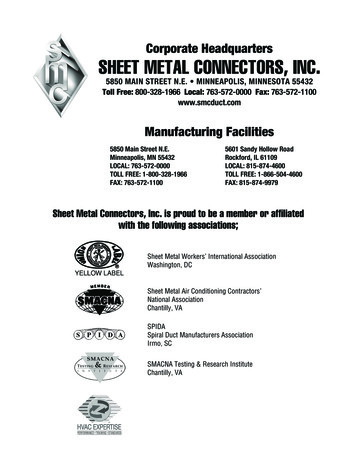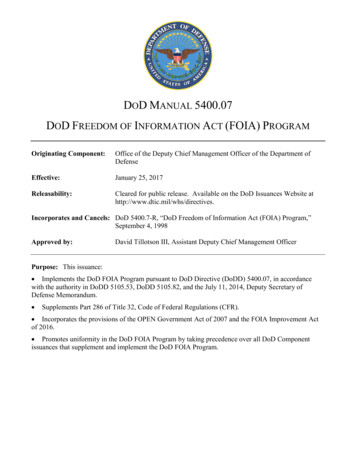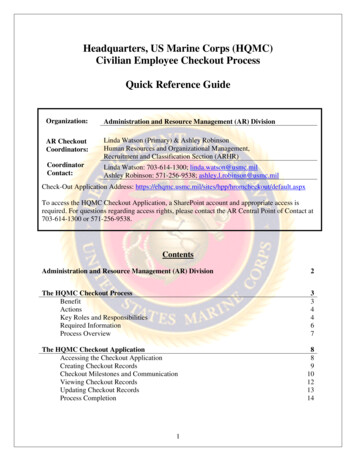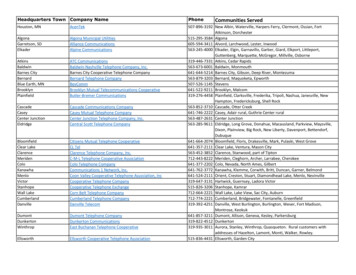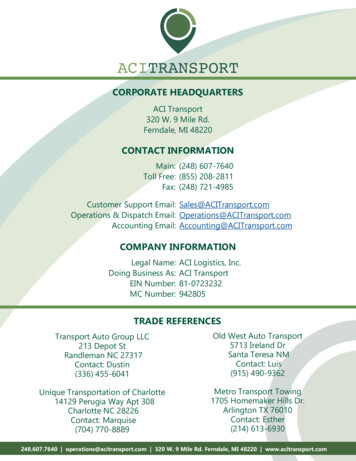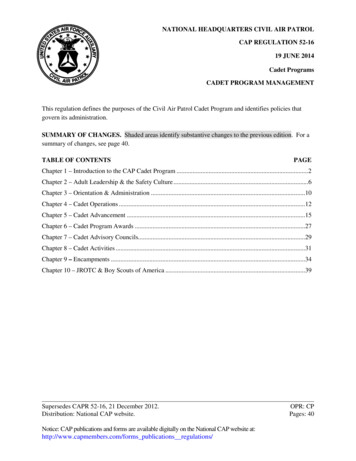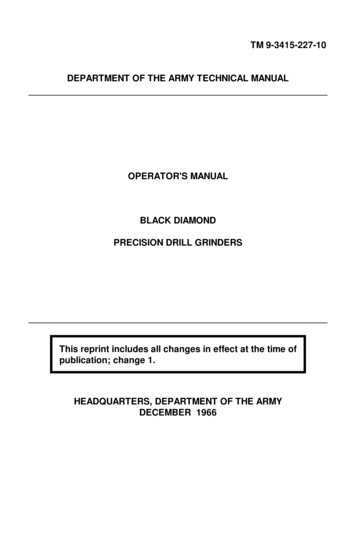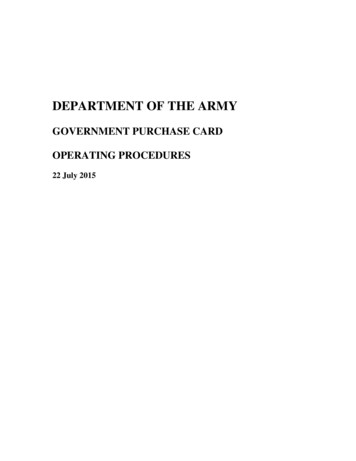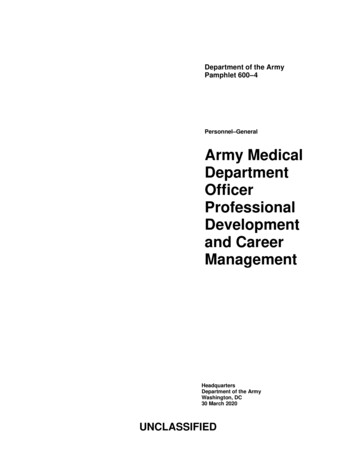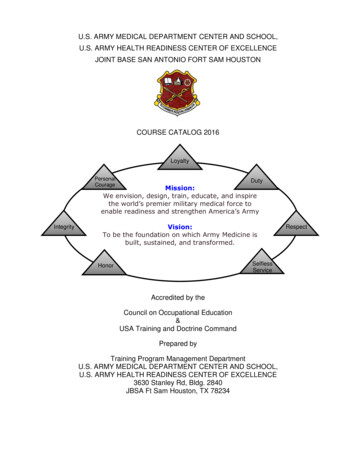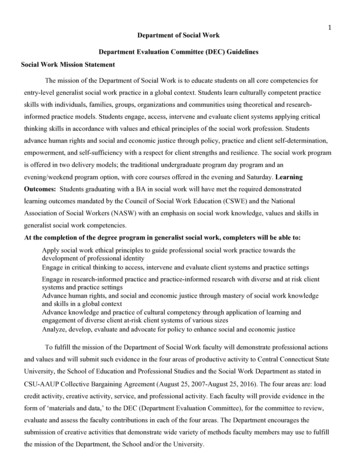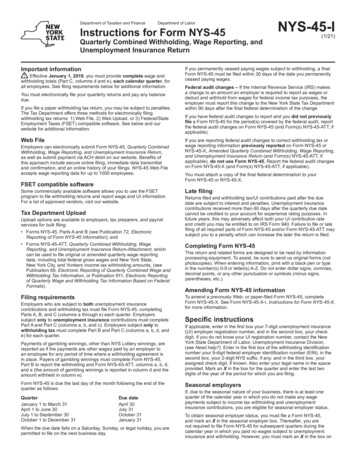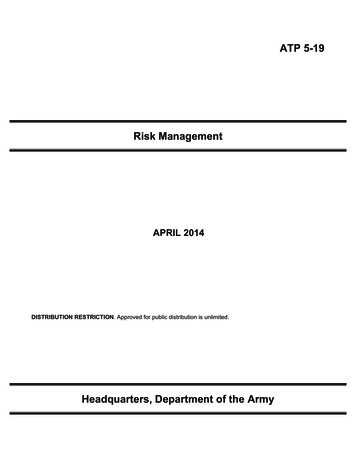
Transcription
ATP 5-19Risk ManagementAPRIL 2014DISTRIBUTION RESTRICTION. Approved for public distribution is unlimited.Headquarters, Department of the Army
This publication is available atArmy Knowledge .html).To receive publishing updates, please subscribe athttp://www.apd.army.mil/AdminPubs/new subscribe.asp.
ATP 5-19, C1HeadquartersDepartment of the ArmyWashington, DC, 8 September 2014Change No. 1Risk Management1.This change replaces DD Form 2977 (Deliberate Risk Assessment Worksheet).2.ATP 5-19, 14 April 2014 is changed as follows:Remove Old PagesInsert New PagesPages i through iiPages i through iiPages 1-7 through 1-8Pages 1-7 through 1-8Pages A-1 through A-10Pages A-1 through A-134.File this transmittal sheet in front of the publication for reference purposes.DISTRIBUTION RESTRICTION: Approved for public release; distribution is unlimited.
ATP 5-19, C18 September 2014By order of the Secretary of the Army:RAYMOND T. ODIERNOGeneral, United States ArmyChief of StaffOfficial:GERALD B. O’KEEFEAdministrative Assistant to theSecretary of the Army1422503DISTRIBUTION:Active Army, Army National Guard, and U.S. Army Reserve: Not to be distributed; electronic mediaonly.PIN: 104084-001
*ATP 5-19HeadquartersDepartment of the ArmyWashington, DC, 14 April 2014Army Techniques PublicationNo. 5-19Risk ManagementContentsPagePREFACE.iiiINTRODUCTION .vChapter 1FOUNDATIONS OF RISK MANAGEMENT . 1-1Principles of Risk Management . 1-1Application Levels of Risk Management . 1-2Steps of Risk Management . 1-3Chapter 2RESPONSIBILITIES . 2-1Army Organizations . 2-1Commanders . 2-1Executive Officers or Chiefs of Staff . 2-2Protection Officers or Operations Officers. 2-2Staffs. 2-2Army Leaders . 2-3Individuals . 2-3Chapter 3APPLICATION TO TROOP LEADING PROCEDURES . 3-1Planning Considerations for Troop Leading Procedures . 3-1Risk Management Techniques for Troop Leading Procedures . 3-5Rapid Decisionmaking and Synchronization Process . 3-10Chapter 4APPLICATION TO THE MILITARY DECISIONMAKING PROCESS . 4-1Planning Considerations for the Military Decisionmaking Process . 4-1Risk Management Techniques for the Military Decisionmaking Process . 4-1Appendix ASAMPLE DD FORM 2977 AND INSTRUCTIONS . A-1GLOSSARY . Glossary-1REFERENCES . References-1INDEX . Index-1Distribution Restriction: Approved for public release; distribution is unlimited.*This publication supersedes FM 5-19, 21 August 2006.8 September 2014ATP 5-19, C1i
ContentsFiguresFigure 1-1. A cyclical, continuous process for managing risk . 1-3Figure 1-2. Assessment steps and management steps . 1-4Figure 3-1. Troop leading procedures correlated with risk management steps. 3-2Figure 3-2. Parallel planning correlated with risk management steps . 3-3Figure 3-3. Information flow in warning orders . 3-4Figure 3-4. Example real-time risk assessment . 3-6Figure 3-5. Company warning order example (handwritten) . 3-7Figure 3-6. Rapid decisionmaking and synchronization process . 3-10Figure 4-1. Sample warning order . 4-4Figure 4-2. Sample graphic incorporating risk management information . 4-5Figure 4-3. Sample running estimate incorporating risk management information . 4-7Figure A-1. Sample DD Form 2977 for tactical road march scenario (page 1) . A-4Figure A-2. Sample DD Form 2977 for tactical road march scenario (page 2) . A-5Figure A-3. Sample DD Form 2977 for tactical aviation scenario (page 1) . A-8Figure A-4. Sample DD Form 2977 for tactical aviation scenario (page 2) . A-9Figure A-5. Sample DD Form 2977 for tactical field artillery scenario (page 1) . A-12Figure A-6. Sample DD Form 2977 for tactical field artillery scenario (page 2) . A-13TablesIntroductory table-1. Risk management in the operations process . vIntroductory table-2. Modified Army terms . viiIntroductory table-3. Rescinded Army terms . viiTable 1-1. Risk assessment matrix . 1-7Table 1-2. Levels of severity and examples of consequences . 1-9Table 1-3. Criteria for effective controls . 1-12Table 1-4. Examples of hazards and controls . 1-13Table 1-5. Evaluation goals . 1-16Table 4-1. Risk management in the military decisionmaking process . 4-2Table 4-2. Sample consolidated preliminary risk assessment worksheet . 4-9Table 4-3. Sample staff section risk briefing matrix . 4-10iiATP 5-19, C18 September 2014
PrefaceATP 5-19 provides doctrinal guidance on managing risk within the conduct of operations. Administrative riskmanagement (RM) guidance and techniques are in DA Pam 385-30. These two documents are designed to becomplimentary, and in tandem, they provide guidance on the implementation of RM throughout the Army.The principal audience for ATP 5-19 is all members of the profession of arms. Commanders, staffs, leaders,Army civilians, and individual Soldiers throughout the Army will use this publication. Commanders and staffsof Army headquarters serving as joint task force or multinational headquarters should also refer to applicablejoint or multinational doctrine concerning the range of military operations and joint or multinational forces.Trainers and educators throughout the Army will also use this publication.Commanders, staffs, and subordinates ensure their decisions and actions comply with applicable U.S.,international, and, in some cases, host-nation laws and regulations. Commanders at all levels ensure theirSoldiers operate in accordance with the law of war and the rules of engagement. (See FM 27-10.)AR 385-10 implements compliance with appropriate federal law and Department of Defense instructions. Itprovides administrative policy on Army safety management procedures. The proponent of ATP 5-19 has madeevery effort to keep this doctrine consistent with AR 385-10 and all appropriate laws, regulations, instructions,and policies. Where Army doctrine differs, the laws, regulations, instructions, and policies take precedence.ATP 5-19 uses joint terms where applicable. Selected joint and Army terms and definitions appear in both theglossary and the text. Terms for which ATP 5-19 is the proponent publication (the authority) are marked withan asterisk (*) in the glossary. Definitions for which ATP 5-19 is the proponent publication are boldfaced in thetext. For other definitions shown in the text, the term is italicized and the number of the proponent publicationfollows the definition.This publication applies to the Active Army, Army National Guard/Army National Guard of the United States,and United States Army Reserve unless otherwise stated.The proponent and preparing agency for ATP 5-19 is the United States Army Training and Doctrine Command.Send comments and recommendations on a DA Form 2028 (Recommended Changes to Publications and BlankForms) to Commander, U.S. Army Training and Doctrine Command, ATTN: ATCS-S (ATP 5-19), 950Jefferson Avenue, Fort Eustis, VA 23604-5700; by e-mail to e@mail.mil or submit an electronic DA Form 2028.14 April 2014ATP 5-19iii
This page intentionally left blank.
IntroductionIn April 1998, FM 100-14 (now obsolete) introduced to the Army the first doctrinal publication onmanaging risk. It detailed the application of a step-by-step process that would conserve combat power andresources. In 2006, FM 5-19 (now obsolete) was released. This milestone publication improved andexpanded the doctrine to provide clear standards and guidance on how to apply the process for managingrisk. The process, then renamed composite risk management, was broadened to encompass all operationsand activities, on- and off-duty. ATP 5-19 retains the holistic approach that focuses on the composite risksfrom all sources, rather than the traditional practice of separating accidents from tactical hazards andassociated risks. With this ATP, the holistic approach is better integrated into the Army’s decisionmakingprocesses. Integration and education are mandated throughout the Soldier and Army civilian’s career. TheArmy, as well as the other Services, has adopted the term risk management (RM) to align with jointterminology. The five steps of RM—identify the hazards, assess the hazards, develop controls and makerisk decisions, implement controls, and supervise and evaluate—are used across the Services to help themoperate as a joint force.RM must be embedded in Army culture. Integrating RM into how we think is crucial to maintaining combatpower and ensuring efficient mission accomplishment. Proper use of this publication will supportstandardization and institutionalization of techniques, tools, and procedures that lead to sounddecisionmaking and valid risk acceptance by Army leaders at all levels. An Army leader is anyone who byvirtue of assumed role or assigned responsibility inspires and influences people to accomplishorganizational goals. Army leaders motivate people both inside and outside the chain of command topursue actions, focus thinking and shape decisions for the greater good of the organization (ADP 6-22).Engaged Army leaders are critical to successful RM.The Army’s overarching framework for exercising mission command is the operations process—the majormission command activities performed during operations: planning, preparing, executing, and continuouslyassessing the operation (ADP 5-0). Throughout the operations process, commanders and staffs integrate thewarfighting functions to synchronize the force in accordance with the commander’s intent and concept ofoperations. Commanders and staffs use several integrating processes and continuing activities to do this.RM is an integrating process. Army leaders first need to understand how RM generally fits into theoperations process. The operations process frames understanding of how RM is integrated with the morecomplex decisionmaking processes. The five steps of RM follow a logical sequence that correlates with theoperations process activities (see introductory table-1). Steps 1 and 2 of RM normally have greatestemphasis in the planning activity. Step 3 normally begins in planning and continues throughout thepreparing activity. The majority of step 4 normally occurs within the preparing and executing activities,with some continuing emphasis in planning. Step 5 normally occurs during executing with some continuingemphasis in planning. The assessment activity of the operations process is continuous. While the depictionin introductory table-1 is in a bar format, both processes are cyclical, fluid, and dynamic. Activities andsteps can overlap or be revisited during any operation.Introductory table-1. Risk management in the operations processOperations process activitiesStep 1–Identify the hazardsPlanningStep 2–Assess the hazardsPlanningStep 3–Develop controls and make risk decisionsPlanning and preparingStep 4–Implement controlsPlanning, preparing, and executingStep 5–Supervise and evaluatePlanning and executing14 April 2014ATP 5-19AssessingRisk management stepsv
IntroductionMission command is the exercise of authority and direction by the commander using mission orders toenable disciplined initiative within the commander’s intent to empower agile and adaptive leaders in theconduct of unified land operations (ADP 6-0). The mission command warfighting function is the relatedtasks and systems that develop and integrate those activities enabling a commander to balance the art ofcommand and the science of control in order to integrate the other warfighting functions (ADRP 3-0). Boththe mission command warfighting function and mission command philosophy encompass and support RM.RM is an invaluable tool for commanders and staff. It provides a systematic and standardized process toidentify hazards and react to changes within an operational environment.All staff elements incorporate RM into their running estimates and provide recommendations for controlsto mitigate risk within their areas of expertise. RM integration during the operations process activities is theprimary responsibility of the unit’s protection officer or the operations officer. The commander has overallresponsibility for RM integration and is the risk acceptance authority.This ATP emphasizes techniques for planning because a significant portion of RM must occur in theplanning activity. During planning, commanders, leaders, and individuals identify potential hazards andassess their likely impact. Steps 1 and 2 of RM—identifying and assessing hazards—provide a structure toenhance situational understanding and support developing sound courses of action and plans. Then,planners can state how forces will accomplish a mission within a predetermined level of risk. Makingoptimal use of planning time is essential for effective RM. The more thorough the planning, the morecontingencies can be ready for implementation. During preparation, leaders balance the risks (such asreadiness, political, economic, and environmental risks) against the costs of each course of action. At thesame time, planners develop actions that mitigate risk (controls), and leaders make risk decisions toeliminate unnecessary risks. Commanders, leaders, and individuals should continually assess the risk leveland effectiveness of controls throughout execution. They should supervise the risk-related activities forwhich they are responsible and monitor other activities directly affecting risk during operations. Any timeor reason risk levels appear to rise or new hazards occur, commanders and leaders should be prepared toorder adjustments to activities, including the actions that mitigate risk. Army leaders use continuousassessments to make adjustments. These cyclical processes support making adjustments where and whenneeded. RM practitioners capture lessons learned to benefit current and future operations.This ATP focuses on the application of RM to troop leading procedures and the military decisionmakingprocess. Chapter 1 emphasizes principles, levels, and steps of RM applicable to both. Chapter 2 outlinesgeneral RM responsibilities of Army organizations, leaders, Soldiers, and Army civilians. Chapter 3explains RM techniques in the context of troop leading procedures. Chapter 4 explains RM techniques inthe context of the military decisionmaking process. An appendix illustrates the use of DD Form 2977(Deliberate Risk Assessment Worksheet).This is a complete revision of FM 5-19 (now obsolete). There have been many changes throughout thepublication. Major changes include— Rescission of the term composite risk management. Adoption of risk management as the name of the process for managing risk. Introduction of DD Form 2977 and rescission of DA Form 7566 (Composite Risk ManagementWorksheet) (now obsolete). Establishment of four RM principles, rather than five. Alignment with the updated steps of the military decisionmaking process and troop leadingprocedures. Increased emphasis on evaluation during the fifth step of RM. The removal of chapters and examples covering nonoperational topics.viATP 5-1914 April 2014
IntroductionIntroductory table-2 lists Army doctrinal terms formerly in FM 5-19 (now obsolete) and modified byATP 5-19. Introductory table-3 lists the doctrinal term rescinded by this ATP.Introductory table-2. Modified Army termsModified Army termsRemarkscontrolFormerly defined as controls.exposureSlightly modified definition.probabilitySlightly modified definition.risk decisionSlightly modified definition.risk toleranceSlightly modified definition.severitySlightly modified definition.accident riskUsed based on plain English; not a defined term.level of riskUsed based on plain English; not a defined term.residual riskUsed based on plain English; not a defined term.tactical riskUsed based on plain English; not a defined term.Introductory table-3. Rescinded Army termsRescinded Army termRemarkscomposite risk managementReplaced by joint term risk management.Unless specified otherwise, any mention of leaders refers to Army leaders. To avoid wordiness, the phraseRM practitioners is used to encompass all individuals and organizations that use RM. This publication usesthe term operations to refer any type of military action or event, including operational, tactical, service,training, or administrative military missions.14 April 2014ATP 5-19vii
This page intentionally left blank.
Chapter 1Foundations of Risk ManagementThis chapter begins by introducing principles of risk management. It continues with adiscussion of the levels of risk management and then concludes with the steps of riskmanagement.PRINCIPLES OF RISK MANAGEMENT1-1. Risk management is the process of identifying, assessing, and controlling risks arising fromoperational factors and making decisions that balance risk cost with mission benefits (JP 3-0). The Armyuses risk management (RM) to help maintain combat power while ensuring mission accomplishment incurrent and future operations. RM applies to operations and to nonoperational activities.Note. For more information on RM application to nonoperational activities, see DA
risk. The process, then renamed composite risk management, was broadened to encompass all operations and activities, on- and off-duty. ATP 5-19 retains the holistic approach that focuses on the composite risks from all sources, rather than the traditional practice of separating accidents from tactical hazards and associated risks.
